《现代会计学(双语)》教学大纲
- 格式:doc
- 大小:150.00 KB
- 文档页数:3
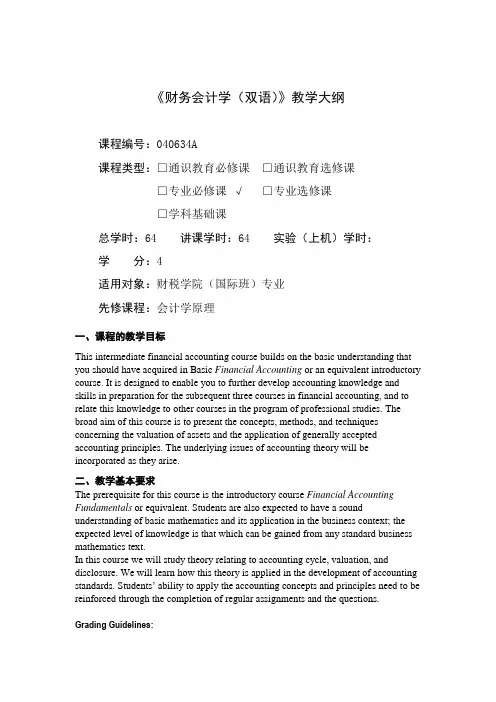
《财务会计学(双语)》教学大纲课程编号:040634A课程类型:□通识教育必修课□通识教育选修课□专业必修课√□专业选修课□学科基础课总学时:64讲课学时:64实验(上机)学时:学分:4适用对象:财税学院(国际班)专业先修课程:会计学原理一、课程的教学目标This intermediate financial accounting course builds on the basic understanding that you should have acquired in Basic Financial Accounting or an equivalent introductory course. It is designed to enable you to further develop accounting knowledge and skills in preparation for the subsequent three courses in financial accounting, and to relate this knowledge to other courses in the program of professional studies. The broad aim of this course is to present the concepts, methods, and techniques concerning the valuation of assets and the application of generally accepted accounting principles. The underlying issues of accounting theory will be incorporated as they arise.二、教学基本要求The prerequisite for this course is the introductory course Financial Accounting Fundamentals or equivalent. Students are also expected to have a sound understanding of basic mathematics and its application in the business context; the expected level of knowledge is that which can be gained from any standard business mathematics text.In this course we will study theory relating to accounting cycle, valuation, and disclosure. We will learn how this theory is applied in the development of accounting standards. Students’ ability to apply the accounting concepts and principles need to be reinforced through the completion of regular assignments and the questions. Grading Guidelines:Exam GuidelinesThe following are guidelines on the type of questions and their approximate三、各教学环节学时分配教学课时分配四、各章教学内容TextbookFinancial & Managerial Accounting---The Basis for Business Decisions 16th edition, Williams, Haka, Bettner, CarcelloChapter 1 Accounting Information for Decision Making1. To discuss accounting as the language of business and the role of accounting information in making economic decisions.2. To discuss the significance of accounting systems in generating reliable accounting information, and understand the five components of internal control per COSO’s Internal Control—Integrated Framework.3. To explain the importance of financial accounting information for external parties —primarily investors and creditors—in terms of the objectives and the characteristics of that information.4.To explain the importance of financial accounting information for internal parties—primarily management—in terms of the objectives and the characteristics of that information.5.To discuss elements of the system of external and internal financial reporting that create integrity in the reported information.6.To identify and discuss several professional organizations that play important roles in preparing and communicating accounting information.7.To discuss the importance of personal competence, professional judgment, and ethical behavior on the part of accounting professionals.8. To discuss various career opportunities in accounting.Chapter 2 BASIC FINANCIAL STATEMENTS1.To explain the nature and general purpose of financial statements.2.To explain certain accounting principles that are important for an understanding offinancial statements and how professional judgment by accountants may affect the application of those principles.3.To demonstrate how certain business transactions affect the elements of theaccounting equation: Assets = Liabilities + Owners’Equity.4.To explain how the statement of financial position, often referred to as the balancesheet, is an expansion of the basic accounting equation.5.To explain how the income statement reports an enterprise’s financialperformance for a period of time in terms of the relationship of revenues and expenses.6.To explain how the statement of cash flows presents the change in cash for aperiod of time in terms of the company’s operating, investing, and financing activities.7.To explain the important relationships among the statement of financial position,income statement, and statement of cash flows, and how these statements relate to each other.8.To explain common forms of business ownership—sole proprietorship,partnership, and corporation—and demonstrate how they differ in terms of their presentation in the statement of financial position.9.To discuss the importance of financial statements to a company and its investorsand creditors and why management may take steps to improve the appearance of the company in its financial statements.Chapter 3 The Accounting Cycle: Capturing Economic Events1.To identify the steps in the accounting cycle and discuss the role of accountingrecords in an organization.2.To describe a ledger account and a ledger.3.To understand how balance sheet accounts are increased and decreased.4.To explain the double-entry system of accounting.5.To explain the purpose of a journal and its relationship to the ledger.6.To explain nature of net income, revenue, and expenses.7.To apply the realization and matching principles in recording revenue andexpenses.8.To understand how revenue and expense transactions are recorded in anaccounting system.9.To prepare a trial balance and explain its uses and limitations.10.To distinguish between accounting cycle procedures and the knowledge ofaccounting.Chapter 4 The Accounting Cycle: Accruals and Deferrals1.To explain the purpose of adjusting entries.2.To describe and prepare the four basic types of adjusting entries.3.To prepare adjusting entries to convert assets to expenses.4.To prepare adjusting entries to convert liabilities to revenue.5.To prepare adjusting entries to accrue unpaid expenses.6.To prepare adjusting entries to accrue uncollected revenue.7.To explain how the principles of realization and matching relate to adjustingentries.8.To explain the concept of materiality.9.To prepare an adjusted trial balance and describe its purpose.Chapter 5 The Accounting Cycle: Reporting Financial Results1.To prepare an income statement, a statement of retained earnings, and a balancesheet.2.To explain how the income statement and the statement of retained earningsrelate to the balance sheet.3.To explain the concept of adequate disclosure.4.To explain the purposes of closing entries; prepare these entries.5.To prepare an after-closing trial balance.6.To use financial statement information to evaluate profitability and liquidity.7.To explain how interim financial statements are prepared in a business that closesits accounts only at year-end.8.To prepare a worksheet and explain its uses.Chapter 6 Merchandising Activities1.To describe the operating cycle of a merchandising company.2.To understand the components of a merchandising company’s income statement.3.To account for purchases and sales of merchandise in a perpetual inventorysystem.4.To explain how a periodic inventory system operates.5.To discuss the factors to be considered in selecting an inventory system.6.To account for additional merchandise transactions related to purchases and sales.7.To define special journals and explain their usefulness.8.To measure the performance of a merchandising business.Chapter 7 Financial Assets1.To define financial assets and explain their valuation in the balance sheet.2.To describe the objectives of cash management and internal controls over cash.3.To prepare a bank reconciliation and explain its purpose.4.To describe how short-term investments are reported in the balance sheet andaccount for transactions involving marketable securities.5.To account for uncollectible receivables using the allowance and direct write-offmethods.6.To explain, compute, and account for notes receivable and interest revenue.7.To evaluate the liquidity of a company’s accounts receivable.Chapter 8 INVENTORIES AND COST OF GOODS SOLD (Self study)1.In a perpetual inventory system, you are to determine the cost of goods sold using(a) specific identification, (b) average cost, (c) FIFO, and (d) LIFO. You should beable to discuss the advantages and shortcomings of each method.2.To explain the need for taking a physical inventory.3.To record shrinkage losses and other year-end adjustments to inventory.4.In a periodic inventory system, you are to determine the cost of goods sold using(a) specific identification, (b) average cost, (c) FIFO, and (d) LIFO.5.To explain the effects on the income statement of errors in inventory valuation.6.To estimate the cost of goods sold and ending inventory by the gross profitmethod and by the retail method.7.To compute the inventory turnover rate and explain its uses.Chapter 9 PLANT AND INTANGIBLE ASSETSThis chapter covers accounting for plant assets, including acquisition, depreciation, and disposal. Also included in the chapter are accounting for intangible assets and brief coverage of natural resources. Teaching objectives in presenting this material are to:1.Describe plant assets as a "stream of services" to be received by the businessentity.2.Distinguish between capital expenditures and revenue expenditures.3.Explain and illustrate depreciation as a technique for allocating costs.4.Explain and illustrate the mechanics of the depreciation methods discussed inthe chapter.5.Explain and illustrate accounting for disposals of plant assets.6.Explain the nature of intangible assets.7.Discuss techniques for estimating the value of the goodwill possessed by asuccessful business.8.Explain and illustrate depletion; relate depreciation, amortization, anddepletion to the matching principle.Chapter 10 LIABILITIESTeaching objectives for Chapter 101.Define liabilities. Distinguish between liabilities and owners' equity.2.Distinguish between current and long-term liabilities.3.Account for notes payable when interest is stated separately.4.Explain the nature of payroll liabilities including payroll taxes and othermandated costs.5.Explain the purpose of an amortization table. Illustrate the preparation anduse of such a table in the context of an installment note payable.6.Discuss the characteristics of corporate bonds including their tax advantages,and the basic journal entries to record their issuance, payment of interest, andredemption.7.Explain the nature of bonds issued at a discount or premium.8.Introduce the concept of present value and its relationship to bond prices.9.Distinguish between capital leases and operating leases and briefly explaintheir accounting treatment.10.Introduce other long-term liabilities including pensions, post-retirementbenefits, and deferred taxes. Describe the presentation of these items in thefinancial statements.11.Describe the cash effects of transactions involving liabilities.12.Explain the usefulness of the debt ratio and the interest coverage ratio.13.Explain the nature of estimated liabilities, loss contingencies, andcommitments. Describe the presentation of these items in financialstatements.Chapter 10 STOCKHOLDERS’ EQUITY: PAID-IN CAPITAL1.In this chapter we provide a comprehensive introduction to factors affectingpaid-in capital and its presentation on the balance sheet. Our teachingobjectives are to:2.Discuss the advantages and disadvantages of corporations.3.Explain the nature of a publicly owned corporation.4.Explain the roles of corporate directors and officers and the rights ofstockholders.5.Illustrate accounting for the issuance of capital stock in exchange for cash orother assets. Explain the role of an underwriter in the issuance of capitalstock.6.Discuss the typical features of preferred stock and contrast these featureswith those of common stock.7.Illustrate the computation of book value per share (with preferred stockoutstanding). Distinguish among the concepts of book value, par value, andmarket value.8.Explain the most important determinants of the market values of preferredand common stock.9.Explain the nature and purpose of stock splits.10.Explain the rationale for treasury stock transactions, and illustrate the relatedaccounting entries.五、主要参考书选用教材:Jan R. Williams, Susan F. Haka, Mark S. Bettner, Joseph V. Carcello,《Financial & Management Accounting : the Basis for Business Decisions》财务会计分册第16版, 机械工业出版社参考书:Donald E. Kieso, Jerry J.Weygandt, Terry D. Warfield,《Intermediate Financial Accounting》,机械工业出版社执笔人:陈杰教研室主任:陈杰系教学主任审核签名:。
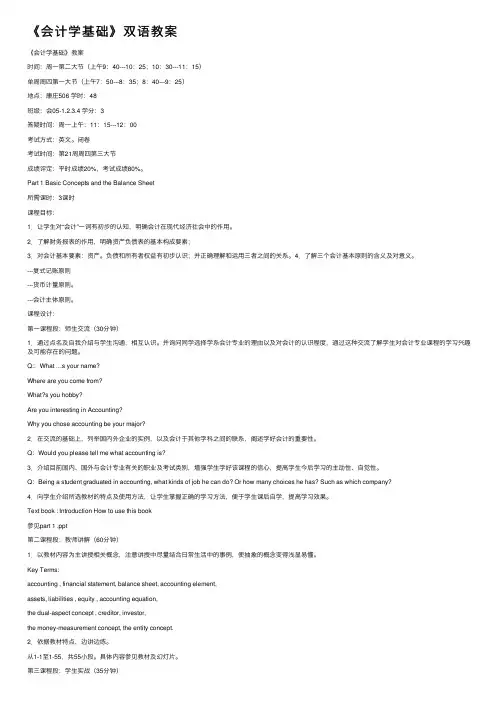
《会计学基础》双语教案《会计学基础》教案时间:周⼀第⼆⼤节(上午9:40---10:25;10:30---11:15)单周周四第⼀⼤节(上午7:50---8:35;8:40---9:25)地点:康庄506 学时:48班级:会05-1.2.3.4 学分:3答疑时间:周⼀上午:11:15---12:00考试⽅式:英⽂。
闭卷考试时间:第21周周四第三⼤节成绩评定:平时成绩20%,考试成绩80%。
Part 1 Basic Concepts and the Balance Sheet所需课时:3课时课程⽬标:1.让学⽣对“会计”⼀词有初步的认知,明确会计在现代经济社会中的作⽤。
2.了解财务报表的作⽤,明确资产负债表的基本构成要素;3.对会计基本要素:资产。
负债和所有者权益有初步认识;并正确理解和运⽤三者之间的关系。
4.了解三个会计基本原则的含义及对意义。
---复式记账原则---货币计量原则。
---会计主体原则。
课程设计:第⼀课程段:师⽣交流(30分钟)1.通过点名及⾃我介绍与学⽣沟通,相互认识。
并询问同学选择学系会计专业的理由以及对会计的认识程度,通过这种交流了解学⽣对会计专业课程的学习兴趣及可能存在的问题。
Q::What …s your name?Where are you come from?What?s you hobby?Are you interesting in Accounting?Why you chose accounting be your major?2.在交流的基础上,列举国内外企业的实例,以及会计于其他学科之间的联系,阐述学好会计的重要性。
Q:Would you please tell me what accounting is?3.介绍⽬前国内、国外与会计专业有关的职业及考试类别,增强学⽣学好该课程的信⼼,提⾼学⽣今后学习的主动性、⾃觉性。
Q:Being a student graduated in accounting, what kinds of job he can do? Or how many choices he has? Such as which company?4.向学⽣介绍所选教材的特点及使⽤⽅法,让学⽣掌握正确的学习⽅法,便于学⽣课后⾃学,提⾼学习效果。
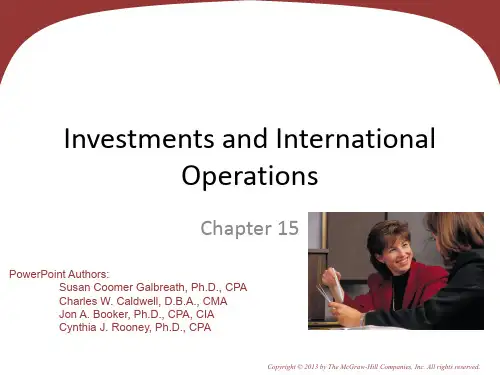
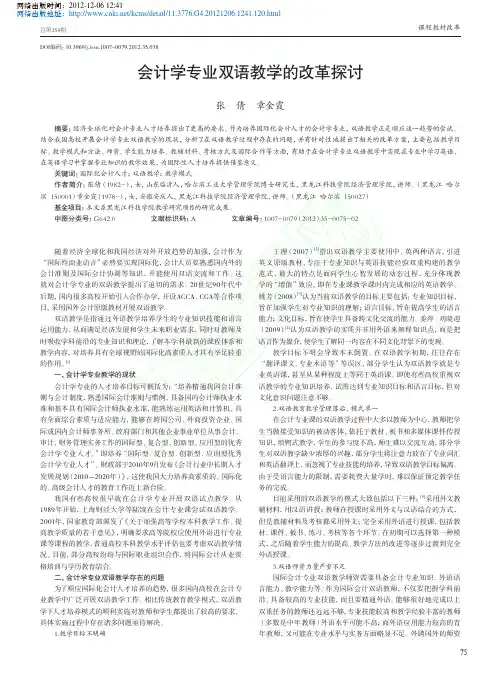
75课程教材改革总第258期随着经济全球化和我国经济对外开放趋势的加强,会计作为“国际性商业语言”必然要实现国际化,会计人员要熟悉国内外的会计准则及国际会计协调等知识,并能使用双语交流和工作。
这就对会计学专业的双语教学提出了迫切的需求。
20世纪90年代中后期,国内很多高校开始引入合作办学,开设ACCA、CGA等合作项目,采用国外会计原版教材开展双语教学。
双语教学是指通过外语教学培养学生的专业知识技能和语言运用能力,从而满足经济发展和学生未来职业需求,同时对教师及时吸收学科前沿的专业知识和理论,了解本学科最新的课程体系和教学内容,对培养具有全球视野的国际化高素质人才具有举足轻重的作用。
[1]一、会计学专业教学的现状会计学专业的人才培养目标可概括为:“培养精通我国会计准则与会计制度,熟悉国际会计准则与惯例,具备国内会计师执业水准和基本具有国际会计师执业水准,能熟练运用英语和计算机,具有全面综合素质与适应能力,能够在跨国公司、外商投资企业、国际或国内会计师事务所、政府部门和其他企业事业单位从事会计、审计、财务管理实务工作的国际型、复合型、创新型、应用型的优秀会计学专业人才。
”即培养“国际型、复合型、创新型、应用型优秀会计学专业人才”。
财政部于2010年9月发布《会计行业中长期人才发展规划(2010-2020年)》,这使我国大力培养高素质的、国际化的、高级会计人才的教育工作迈上新台阶。
我国有些高校很早就在会计学专业开展双语试点教学。
从1989年开始,上海财经大学等陆续在会计专业课尝试双语教学。
2001年,国家教育部颁发了《关于加强高等学校本科教学工作、提高教学质量的若干意见》,明确要求高等院校应使用外语进行专业课等课程的教学,普通高校本科教学水平评估也要考虑双语教学情况。
目前,部分高校纷纷与国际职业组织合作,将国际会计从业资格培训与学历教育结合。
二、会计学专业双语教学存在的问题为了顺应国际化会计人才培养的趋势,很多国内高校在会计专业教学中广泛开展双语教学工作。
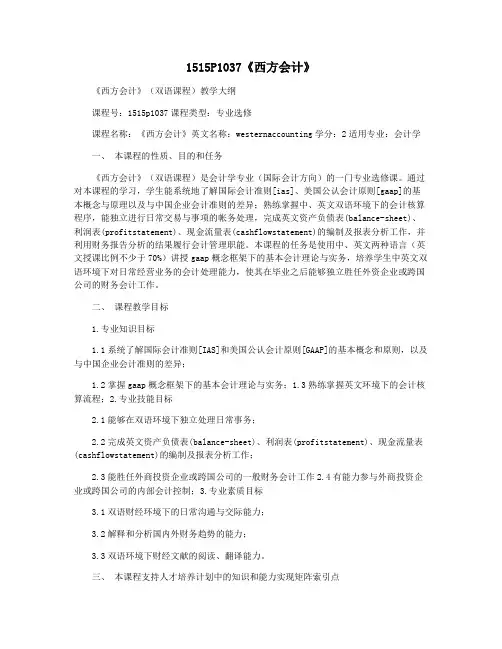
1515P1037《西方会计》《西方会计》(双语课程)教学大纲课程号:1515p1037课程类型:专业选修课程名称:《西方会计》英文名称:westernaccounting学分:2适用专业:会计学一、本课程的性质、目的和任务《西方会计》(双语课程)是会计学专业(国际会计方向)的一门专业选修课。
通过对本课程的学习,学生能系统地了解国际会计准则[ias]、美国公认会计原则[gaap]的基本概念与原理以及与中国企业会计准则的差异;熟练掌握中、英文双语环境下的会计核算程序,能独立进行日常交易与事项的帐务处理,完成英文资产负债表(balance-sheet)、利润表(profitstatement)、现金流量表(cashflowstatement)的编制及报表分析工作,并利用财务报告分析的结果履行会计管理职能。
本课程的任务是使用中、英文两种语言(英文授课比例不少于70%)讲授gaap概念框架下的基本会计理论与实务,培养学生中英文双语环境下对日常经营业务的会计处理能力,使其在毕业之后能够独立胜任外资企业或跨国公司的财务会计工作。
二、课程教学目标1.专业知识目标1.1系统了解国际会计准则[IAS]和美国公认会计原则[GAAP]的基本概念和原则,以及与中国企业会计准则的差异;1.2掌握gaap概念框架下的基本会计理论与实务;1.3熟练掌握英文环境下的会计核算流程;2.专业技能目标2.1能够在双语环境下独立处理日常事务;2.2完成英文资产负债表(balance-sheet)、利润表(profitstatement)、现金流量表(cashflowstatement)的编制及报表分析工作;2.3能胜任外商投资企业或跨国公司的一般财务会计工作2.4有能力参与外商投资企业或跨国公司的内部会计控制;3.专业素质目标3.1双语财经环境下的日常沟通与交际能力;3.2解释和分析国内外财务趋势的能力;3.3双语环境下财经文献的阅读、翻译能力。
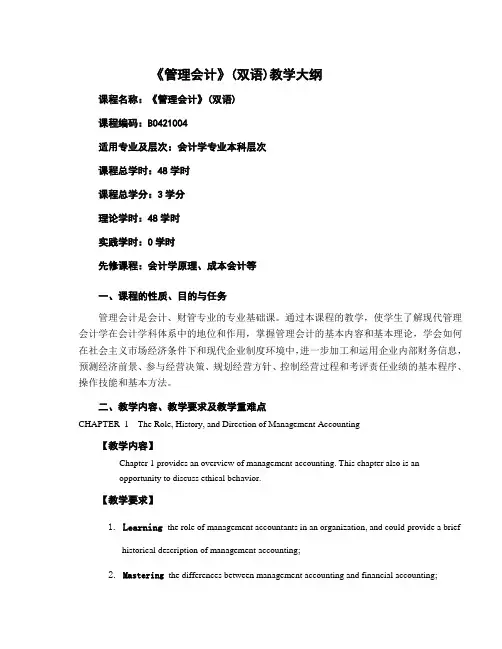
《管理会计》(双语)教学大纲课程名称:《管理会计》(双语)课程编码:B0421004适用专业及层次:会计学专业本科层次课程总学时:48学时课程总学分:3学分理论学时:48学时实践学时:0学时先修课程:会计学原理、成本会计等一、课程的性质、目的与任务管理会计是会计、财管专业的专业基础课。
通过本课程的教学,使学生了解现代管理会计学在会计学科体系中的地位和作用,掌握管理会计的基本内容和基本理论,学会如何在社会主义市场经济条件下和现代企业制度环境中,进一步加工和运用企业内部财务信息,预测经济前景、参与经营决策、规划经营方针、控制经营过程和考评责任业绩的基本程序、操作技能和基本方法。
二、教学内容、教学要求及教学重难点CHAPTER 1 The Role, History, and Direction of Management Accounting【教学内容】Chapter 1 provides an overview of management accounting. This chapter also is anopportunity to discuss ethical behavior.【教学要求】1. Learning the role of management accountants in an organization, and could provide a briefhistorical description of management accounting;2. Mastering the differences between management accounting and financial accounting;3. Understanding the current focus of management accounting,and the importance of ethicalbehavior for managers and management accountants【教学重难点】1. Mastering the differences between management accounting and financial accounting;2. Understanding the current focus of management accounting.CHAPTER 2 Basic Management Accounting Concepts【教学内容】This chapter introduces basic terminology that is used throughout the text. Accounting issometimes called the language of business. Learning the accounting terminology in Chapter 2 is similar to learning a foreign language. Understanding the accounting terminology in Chapter 2 is crucial to students understanding topics covered later.【教学要求】1. Learning tangible and intangible products and explain why there are different product costdefinitions;2. Mastering could prepare income statements for manufacturing and service organizations;3. Understanding the cost assignment process, and the differences between functional-based andactivity-based management accounting systems.【教学重难点】1. Mastering could prepare income statements for manufacturing and service organizations;2. Learning tangible and intangible products and explain why there are different product costdefinitions;CHAPTER 3 Activity Cost Behavior【教学内容】This chapter expands the discussion of cost behavior in Chapter 2; more specifically, it focuses on activity cost behavior. In addition, the resource usage model is presented. This chapter is an important foundation for the activity-based costing system discussed in the next chapter. In addition, several methods to estimate and evaluate the cost equation are discussed.【教学要求】1. Learning cost behavior for fixed, variable, and mixed costs , and the role of multipleregression in assessing cost behavior ;2.Mastering how to separate mixed costs into their fixed and variable components using thehigh-low method, the scatter plot method, and the method of least squares ;3. Understanding the role of the resource usage model in understanding cost behavior, and theuse of managerial judgment in determining cost behavior.【教学重难点】1. Mastering how to separate mixed costs into their fixed and variable components using thehigh-low method, the scatter plot method, and the method of least squares ;2. Understanding the role of the resource usage model in understanding cost behavior, and theuse of managerial judgment in determining cost behavior.CHAPTER 4 Activity-Based Costing【教学内容】Technological changes in manufacturing have made the traditional costing method obsolete in many firms. Unit-based cost systems often are no longer adequate in measuring product costs because overhead costs have increased while direct labor costs have decreased. This chapter introduces an approach that can improve product costing in many firms.【教学要求】1. Learning the importance of unit costs, a detailed description of how activities can be grouped intohomogeneous sets to reduce the number of activity rates2. Mastering how an activity-based costing system works, activity-based customer and suppliercosting;3. Understanding functional-based costing approaches, and why functional-based costingapproaches may produce distorted costs.【教学重难点】1. Mastering how an activity-based costing system works, activity-based customer and suppliercosting;2. Understanding functional-based costing approaches, and why functional-based costingapproaches may produce distorted costs.CHAPTER 5 Job-Order Costing【教学内容】Product costing plays a critical role in the new manufacturing environment and has become a significant factor in the service industries with the impact of deregulation. Nonaccounting majors should realize that understanding the basics of product costing is an important topic covered in the course. This chapter introduces students to the important topic of job-order costing.【教学要求】1. Mastering the differences between job-order costing and process costing, and identify the types offirms that would use each method, and the cost flows associated with job-order costing;2. Understanding how to identify and set up the source documents used in job-order costing.【教学重难点】Mastering the differences between job-order costing and process costing, and identify the typesof firms that would use each method, and the cost flows associated with job-order costing; CHAPTER 6 Process Costing【教学内容】If time permits, coverage of process costing is recommended. It exposes students to a different method of determining costs for products and provides useful insights in later chapters. The material in this chapter is generally difficult for the students because of the amount of detail. If you wish to cover this lightly, I suggest you focus on the weighted average approach.【教学要求】1. Learning the basic characteristics and cost flows associated with process manufacturing, and equivalent units and explain their role in process costing2. Mastering the differences between the weighted average method and the FIFO method ofaccounting for process costs, and prepare a departmental production report using the weighted average method;3. Understanding how to how process costing is affected by nonuniform application of manufacturinginputs and the existence of multiple processing departments.【教学重难点】1. Mastering the differences between the weighted average method and the FIFO method ofaccounting for process costs, and prepare a departmental production report using the weightedaverage method;2. Understanding how to how process costing is affected by nonuniform application of manufacturinginputs and the existence of multiple processing departments.CHAPTER 7 Support Department Cost Allocation【教学内容】Allocation of support-department costs is an important topic for product costing. In recent years the issue of accurate product costing has assumed considerable importance, and managers need to be fully aware of how products are costed and the limitations associated with those assignments. The introductory scenario discusses a copying department in a large regional public accounting firm.【教学要求】1. Mastering how to calculate single charging rates for a support department, and allocatesupport-department costs to producing departments using the direct, sequential, and reciprocalmethods, and calculate departmental overhead rate;2. Understanding the difference between support departments and producing departments..【教学重难点】1. Mastering how to calculate single charging rates for a support department, and allocatesupport-department costs to producing departments using the direct, sequential, and reciprocalmethods, and calculate departmental overhead rate;CHAPTER 8 Functional and Activity-Based Budgeting【教学内容】Budgeting is one topic that most students can relate to since they are involved with their own personal budgets. Students may benefit by reading the scenario at the beginning of the chapter.【教学要求】1. Learning budgeting and discuss its role in planning, control, and decision making;2. Mastering the master budget, identify its major components, and explain the interrelationships of thevarious components, and flexible budgeting and identify the features that a budgetary system should have to encourage managers to engage in goal-congruent behavior.3. Understanding activity-based budgeting.【教学重难点】1.Mastering the master budget, identify its major components, and explain the interrelationships of the various components, and flexible budgeting and identify the features that a budgetary system should have to encourage managers to engage in goal-congruent behavior.2. Understanding activity-based budgeting.CHAPTER 9 Standard Costing: A Managerial Control Tool【教学内容】This chapter covers standard costing and variances.【教学要求】1. Learning how unit standards are set and why standard cost systems are adopted, and the purpose of a standard cost sheet.2. Mastering how to compute the materials and labor variances and explain how they are used forcontrol, and the variable and fixed overhead variances and explain their meanings;3. Understanding the basic concepts underlying variance analysis and explain when variances should beInvestigated.【教学重难点】1. Mastering how to compute the materials and labor variances and explain how they are used forcontrol, and the variable and fixed overhead variances and explain their meanings;2. Understanding the basic concepts underlying variance analysis and explain when variances should beInvestigated.CHAPTER 10 Activity- and Strategic-Based Responsibility Accounting【教学内容】Activity-based management is a fairly new topic in management accounting textbooks. This chapter is important in order to understand the new environment in management accounting. The scenario to Chap- ter 10 is a good place for students to start. In addition, students should be comfortable with the topics from Chapters 3 and 4.【教学要求】1. Learning the difference among functional-based, activity-based, and strategic-based responsibilityaccounting systems.2. Mastering the basic features of the Balanced Scorecard;3. Understanding process value analysis and activity performance measurement.【教学重难点】1. Mastering the basic features of the Balanced Scorecard;2. Understanding process value analysis and activity performance measurement.CHAPTER 11 Quality Costs and Productivity: Measurement, Reporting, and Control【教学内容】This chapter focuses on the measurement and control of quality costs, and does a good job of discussing a topic that is not presented in most first-level management accounting textbooks. It provides an excellent bridge to understanding the new manufacturing environment of a world-class manufacturer. The opening scenario provides an interesting discussion of quality issues.【教学要求】1. Learning the four types of quality costs;2. Mastering how to prepare a quality cost report and explain the difference between the conventionalview of acceptable quality level and the view espoused by total quality control and why quality cost information is needed and how it is used;3. Understanding what productivity is and calculate the impact of productivity changes on profits.【教学重难点】1.Mastering how to prepare a quality cost report and explain the difference between theconventional view of acceptable quality level and the view espoused by total quality control and why quality cost information is needed and how it is used;2. Understanding what productivity is and calculate the impact of productivity changes on profits. CHAPTER 12 Environmental Cost Management【教学内容】In this chapter, Hansen and Mowen discuss environmental and life-cycle costs. These issues are presented in the scenario at the beginning of the chapter.【教学要求】1. Learning the importance of measuring environmental costs;2. Mastering how environmental costs are assigned to products and processes;3. Understanding the life-cycle cost assessment model, and activity- and strategic-based environmentalcontrol.【教学重难点】1. Mastering how environmental costs are assigned to products and processes;2. Understanding the life-cycle cost assessment model, and activity- and strategic-based environmentalcontrol.CHAPTER 13 Performance Evaluation in the Decentralized Firm【教学内容】The scenario in this chapter illustrates some of the issues faced by firms selling abroad. This chapter is relevant because of global competition faced by many firms.【教学要求】1. Learning responsibility accounting and four types of responsibility centers;2. Mastering how to compute and explain return on investment (ROI) and economic value added(EVA);3. Understanding why firms choose to decentralize, and methods of evaluating and rewarding managerial performance, the role of transfer pricing in a decentralized firm.【教学重难点】Mastering how to compute and explain return on investment (ROI) and economic value added(EVA);CHAPTER 14 International Issues in Management Accounting【教学内容】The scenario in this chapter illustrates some of the issues faced by firms selling abroad. This chapter is relevant because of global competition faced by many firms.【教学要求】1. Learning the role of the management accountant in the international environment, and the varying levels of involvement that firms can undertake in international trade;2. Mastering the ways management accountants can manage foreign currency risk,3. Understanding why multinational firms choose to decentralize, and how environmental factors can affect performance evaluation in the multinational firm, and the role of transfer pricing in the multinational firm.【教学重难点】1. Mastering the ways management accountants can manage foreign currency risk;2. Understanding why multinational firms choose to decentralize, and how environmental factors canaffect performance evaluation in the multinational firm, and the role of transfer pricing in themultinational firm.CHAPTER 15 Segmented Reporting and Performance Evaluation【教学内容】Coverage of this chapter expands on material outlined briefly in Chapter 2. Here we use thevariable-costing income statement as a way to organize information on cost behavior. A variety of management decision-making applications are presented.【教学要求】1. Learning the differences between variable and absorption costing;2. Mastering how variable costing is useful in evaluating the performance of managers, and how to prepare a segmented income statement based on a variable-costing approach and explain how this format can be used with activity-based costing to assess customer profitability.3. Understanding why multinational firms choose to decentralize, and how environmental factors can affect performance evaluation in the multinational firm, and the role of transfer pricing in the multinational firm.【教学重难点】1. Mastering how variable costing is useful in evaluating the performance of managers, and how to prepare a segmented income statement based on a variable-costing approach and explain how this format can be used with activity-based costing to assess customer profitability.2. Understanding why multinational firms choose to decentralize, and how environmental factors can affect performance evaluation in the multinational firm, and the role of transfer pricing in the multinational firm.CHAPTER 16 Cost-Volume-Profit Analysis: A Managerial Planning Tool【教学内容】Cost-volume-profit (CVP) analysis can be used to illustrate how managers use accounting data for planning and decision making. Students who enjoy solving puzzles will probably enjoy the discussion of CVP. A more complete analysis of the subject material can be taught by using simple algebra.【教学要求】1. Learning the impact of activity-based costing on cost-volume-profit analysis;2. Mastering the number of units that must be sold to break even or to earn a targeted profit., the amount of revenue required to break even or to earn a targeted profit, and apply cost-volume-profit analysis in a multiple-product setting;3.Understanding a profit-volume graph and a cost-volume-profit graph and explain themeaning of each, and the impact of risk, uncertainty, and changing variables on cost-volume-profit analysis.【教学重难点】Mastering the number of units that must be sold to break even or to earn a targeted profit., theamount of revenue required to break even or to earn a targeted profit, and apply cost-volume-profit analysis in a multiple-product setting;CHAPTER 17 Tactical Decision Making【教学内容】This chapter deals with relevant information and how it is used in short-run decisions.【教学要求】1. Learning the tactical decision-making model;2. Mastering how the activity resource usage model is used in assessing relevancy, and how to apply the tactical decision-making concepts in a variety of business situations.3.Understanding the impact of cost on pricing decisions.【教学重难点】Mastering how the activity resource usage model is used in assessing relevancy, and how to apply the tactical decision-making concepts in a variety of business situations.CHAPTER 18 Capital Investment Decisions【教学内容】This chapter covers the basic capital budgeting models. Taxes are considered later in the chapter. The focus of the chapter is on learning how to apply the models.【教学要求】1. Learning what a capital investment decision is and distinguish between independent and mutually exclusive capital investment decisions;2. Mastering how to compute the payback period and accounting rate of return for a proposed investment and explain their roles in capital investment decisions, and use net present value analysis for capital investment decisions involving independent projects, and use the internal rate of return to assess the acceptability of independent projects.3. Understanding the role and value of postaudits, and why NPV is better than IRR for capitalinvestment decisions involving mutually exclusive projects.【教学重难点】Mastering how to compute the payback period and accounting rate of return for a proposed investmentand explain their roles in capital investment decisions, and use net present value analysis for capital investment decisions involving independent projects, and use the internal rate of return to assess the acceptability of independent projects.CHAPTER 19 Inventory Management【教学内容】The material in this chapter tends to be more quantitative than in previous chapters. While thematerial is very important to many management accountants, the discussion of these topics is often delayed until the second managerial/cost accounting class.【教学要求】1. Learning the traditional inventory management model, and the theory of constraints and explain how it can be used to manage inventory.2. Understanding JIT inventory management, and long-term contracts, continuous replenishment, electronic data interchange, and JIT II.【教学重难点】Understanding JIT inventory management, and long-term contracts, continuous replenishment, electronic data interchange, and JIT II.三、教学章节及学时分配(一)总体学时分配四、教学方法与教学手段说明教学方法式是以普通理论课堂教学和案例教学为主要形式,注重培养学生活学活用的能力。
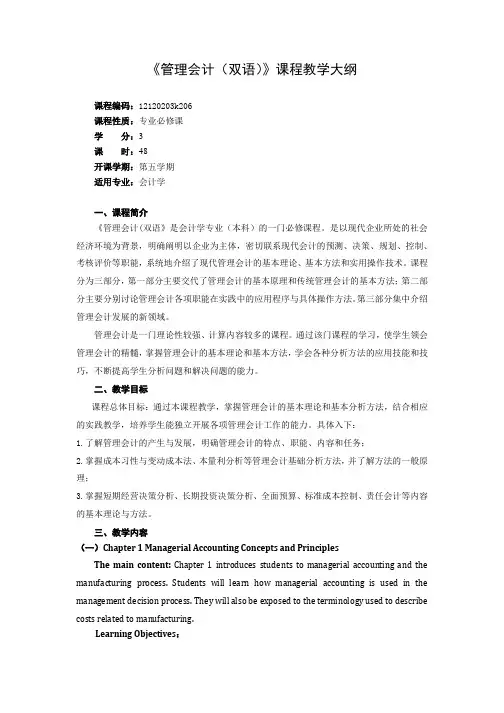
《管理会计(双语)》课程教学大纲课程编码:12120203k206课程性质:专业必修课学分:3课时:48开课学期:第五学期适用专业:会计学一、课程简介《管理会计(双语》是会计学专业(本科)的一门必修课程。
是以现代企业所处的社会经济环境为背景,明确阐明以企业为主体,密切联系现代会计的预测、决策、规划、控制、考核评价等职能,系统地介绍了现代管理会计的基本理论、基本方法和实用操作技术。
课程分为三部分,第一部分主要交代了管理会计的基本原理和传统管理会计的基本方法;第二部分主要分别讨论管理会计各项职能在实践中的应用程序与具体操作方法。
第三部分集中介绍管理会计发展的新领域。
管理会计是一门理论性较强、计算内容较多的课程。
通过该门课程的学习,使学生领会管理会计的精髓,掌握管理会计的基本理论和基本方法,学会各种分析方法的应用技能和技巧,不断提高学生分析问题和解决问题的能力。
二、教学目标课程总体目标:通过本课程教学,掌握管理会计的基本理论和基本分析方法,结合相应的实践教学,培养学生能独立开展各项管理会计工作的能力。
具体入下:1.了解管理会计的产生与发展,明确管理会计的特点、职能、内容和任务;2.掌握成本习性与变动成本法、本量利分析等管理会计基础分析方法,并了解方法的一般原理;3.掌握短期经营决策分析、长期投资决策分析、全面预算、标准成本控制、责任会计等内容的基本理论与方法。
三、教学内容(一)Chapter 1 Managerial Accounting Concepts and PrinciplesThe main content: Chapter 1 introduces students to managerial accounting and the manufacturing process. Students will learn how managerial accounting is used in the management decision process. They will also be exposed to the terminology used to describe costs related to manufacturing.Learning Objectives:After studying the chapter, your students should be able to:1. Describe managerial accounting and the role of managerial accounting in a business.2. Define and illustrate the following costs: 1. direct and indirect costs, 2. direct materials,direct labor, and factory overhead costs, 3. product and period costs.3. Describe and illustrate the following statements for a manufacturing business: 1.balance sheet, 2. statement of cost of goods manufactured, 3. income statement.4. Describe the uses of managerial accounting information.Some key points: direct and indirect costs, direct materials, direct labor, factory overhead costs, product and period costs; cost of goods manufactured.Teaching methods: use of multimedia tools. We ad opt Classroom-based teaching, which is supplemented by the necessary classroom discussion. Besides,arrange stud ents to d o some appropriate exercises and self-extending reading after class.(二)Chapter 2Job Order CostingThe main content:Chapter 2 introduces students to managerial job order cost systems. Students will be exposed to the terminology used to describe costs related to manufacturing. The first of two basic manufacturing accounting systems, job order, is described in this chapter. Students learn how costs flow through a manufacturing system and the basis for determining product costs under job order costing.Learning Objectives:After studying the chapter, your students should be able to:1. Describe cost accounting systems used by manufacturing businesses.2. Describe and illustrate a job order cost accounting system.3. Describe the use of job order cost information for decision making.4. Describe the flow of costs for a service business that uses a job order cost accountingsystem.Some key points: Job Order Cost System; Overapplied Factory Overhead; Underapplied Factory Overhead; predetermined overhead rate;Teaching methods: use of multimedia tools. We adopt Classroom-based teaching, which is suppl emented by the necessary classroom discussion. Besides,arrange stud ents to d o some appropriate exercises and self-extending reading after class.(三)Chapter 3Process Cost SystemsThe main content:Chapter 3 completes the coverage of manufacturing accounting by introducing process costing. The text demonstrates process costing under the FIFO method.The average cost method is presented in th e chapter’s appendix. Chapter 3 also discusses the impact of just-in-time systems on manufacturing.Learning Objectives:After studying the chapter, your students should be able to:1. Describe process cost systems.2. Prepare a cost of production report.3. Journalize entries for transactions using a process cost system.4. Describe and illustrate the use of cost of production reports for decision making.5. Compare just-in-time processing with traditional manufacturing processing.Some key points: Process Cost System; First-in, First-out (FIFO) Method; Cost of Production Report; Just-in-Time (JIT) Processing.Teaching methods: use of multimedia tools. We adopt Classroom-based teaching, which is supplemented by the necessary classroom discussion. Besides,arrange students to do some appropriate exercises and self-extending reading after class.(四)Chapter 4 Cost Behavior and Cost-Volume-Profit AnalysisThe main content: In Chapter 4, students learn how to conduct cost-volume-profit analysis. In preparation for this activity, the chapter discusses variable, fixed, and mixed costs.Learning Objectives:After studying the chapter, your students should be able to:1. Classify costs as variable costs, fixed costs, or mixed costs.2. Compute the contribution margin, the contribution margin ratio, and the unitcontribution margin.3. Determine the break-even point and sales necessary to achieve a target profit.4. Using a cost-volume-profit chart and a profit-volume chart, determine the break-evenpoint and sales necessary to achieve a target profit.5. Compute the break-even point for a company selling more than one product, theoperating leverage, and the margin of safety.Some key points:variable costs; fixed costs; mixed costs; High-Low Method; Contribution Margin; Cost-Volume-Profit Analysis; Contribution Margin Ratio; Unit Contribution Margin.Teaching methods: use of multimedia tools. We adopt Classroom-based teaching, which is supplemented by the necessary classroom discussion. Besides,arrange students to do some appropriate exercises and self-extending reading after class.(五)Chapter 5 BudgetingThe main content: Chapter 5 emphasizes accounting activities that help managers plan, direct, and control the operations of a business. Budgeting is used to establish business goals in the planning function. Budgets help guide managers’ operational decisions. Budgets are also used to control operations as actual results are compared to the budgeted results.Learning Objectives:After studying the chapter, your students should be able to:1. Describe budgeting, its objectives, and its impact on human behavior.2. Describe the basic elements of the budget process, the two major types of budgeting,and the use of computers in budgeting.3. Describe the master budget for a manufacturing company.4. Prepare the basic income statement budgets for a manufacturing company.5. Prepare balance sheet budgets for a manufacturing company.Some key points: Goal Conflict;Budgetary Slack;Continuous Budgeting;Static Budget;Flexible Budget;Zero-Based Budgeting;Capital Expenditures Budget.Teaching methods: use of multimedia tools. We adopt Classroom-based teaching, which is supplemented by the necessary classroom discussion. Besides,arrange students to do some appropriate exercises and self-extending reading after class.(六)Chapter 6 Performance Evaluation Using Variances from Standard Costs The main content: Standard cost systems set budgets for the materials, labor, and factory overhead used by a manufacturer to produce its product. Deviations from these standards are reported as variances.Learning Objectives:After studying the chapter, your students should be able to:1. Describe the types of standards and how they are established.2. Describe and illustrate how standards are used in budgeting.3. Compute and interpret direct materials and direct labor variances.4. Compute and interpret factory overhead controllable and volume variances.5. Journalize the entries for recording standards in the accounts and prepare an incomestatement that includes variances from standard.6. Describe and provide examples of nonfinancial performance measures.Some key points: Direct Labor Rate Variance ;Direct Materials Price Variance;Direct Labor Time Variance;Direct Materials Quantity Variance;Budgeted Variable Factory Overhead;Factory Overhead Cost Variance Report;Controllable Variance;Volume Variance.Teaching methods: use of multimedia tools. We adopt Classroom-based teaching, which is supplemented by the necessary classroom discussion. Besides,arrange students to do some appropriate exercises and self-extending reading after class.(七)Chapter 7 Performance Evaluation for Decentralized Operations The main content: Chapter 7 applies responsibility accounting to cost, profit, and investment centers. The chapter demonstrates the responsibility accounting reports that are used to evaluate department or division performance. This provides an excellent opportunity to remind your students that managers are judged, at least in part, using accounting data.Learning Objectives:After studying the chapter, your students should be able to:1. Describe the advantages and disadvantages of decentralized operations.2. Prepare a responsibility accounting report for a cost center.3. Prepare responsibility accounting reports for a profit center.4. Compute and interpret the rate of return on investment, the residual income, and thebalanced scorecard for an investment center.5. Describe and illustrate how the market price, negotiated price, and cost priceapproaches to transfer pricing may be used by decentralized segments of a business.Some key points:Responsibility Accounting;Balanced Scorecard;Profit Margin;DuPont Formula;Rate of Return on Investment (ROI);Investment Center ;Residual Income;Investment TurnoverTeaching methods: use of multimedia tools. We adopt Classroom-based teaching, which is supplemented by the necessary classroom discussion. Besides,arrange students to do some appropriate exercises and self-extending reading after class.(八)Chapter 8 Differential Analysis, Product Pricing, and Activity-Based Costing The main content: This chapter covers (1) differential analysis, (2) methods of determining the selling price of a product using a cost-plus markup approach, (3) the effects of production bottlenecks, and (4) activity-based costing. The cost-plus approach of product cost is described in Objective 2; total cost and variable cost methods are presented in thechapter appendix. All topics in this chapter are able to stand alone. Therefore, the instructor is free to cover only one or two of the topics if class time is a limited resource as the term draws to a close.Learning Objectives:After studying the chapter, your students should be able to:1. Prepare differential analysis reports for a variety of managerial decisions.2. Determine the selling price of a product, using the product cost concept.3. Compute the relative profitability of products in bottleneck production processes.4. Allocate product costs using activity-based costing.Some key points:Product Cost Concept ; Target Costing; Production Bottleneck; Theory of Constraints (TOC); Activity-Based Costing (ABC).Teaching methods: use of multimedia tools. We adopt Classroom-based teaching, which is supplemented by the necessary classroom discussion. Besides,arrange students to do some appropriate exercises and self-extending reading after class.(九)Chapter 9 Capital Investment AnalysisThe main content: Capital investment analysis is a topic that usually receives detailed coverage in introductory finance courses and/or intermediate accounting. The purpose of this chapter is to give students a brief introduction to the basics of capital investment analysis using the following methods: average rate of return, cash payback, net present value, and internal rate of return.Learning Objectives:After studying the chapter, your students should be able to:1. Explain the nature and importance of capital investment analysis.2. Evaluate capital investment proposals using the average rate of return and cashpayback methods.3. Evaluate capital investment proposals using the net present value and internal rate ofreturn methods.4. List and describe factors that complicate capital investment analysis.5. Diagram the capital rationing process.Some key points: Capital Investment Analysis;Time Value of Money Concept;Average Rate of Return;Cash Payback Period;Internal Rate of Return (IRR) Method;Capital Rationing.Teaching methods: use of multimedia tools. We adopt Classroom-based teaching, which is supplemented by the necessary classroom discussion. Besides,arrange students to do some appropriate exercises and self-extending reading after class.四、整体课时分配五、实验教学1. 实验项目与课时分配3.实验报告The basic requirements of the experiment report, including: name of the experiment, purpose of the experiment, case data, case analysis, conclusions and enlightenment.六、课程考核与成绩评定1.考核方式:考查;笔试;闭卷。
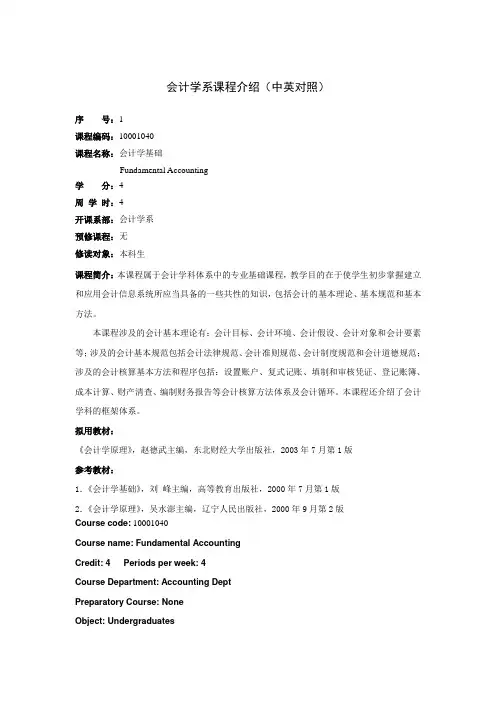
会计学系课程介绍(中英对照)序号:1课程编码:10001040课程名称:会计学基础Fundamental Accounting学分:4周学时:4开课系部:会计学系预修课程:无修读对象:本科生课程简介:本课程属于会计学科体系中的专业基础课程,教学目的在于使学生初步掌握建立和应用会计信息系统所应当具备的一些共性的知识,包括会计的基本理论、基本规范和基本方法。
本课程涉及的会计基本理论有:会计目标、会计环境、会计假设、会计对象和会计要素等;涉及的会计基本规范包括会计法律规范、会计准则规范、会计制度规范和会计道德规范;涉及的会计核算基本方法和程序包括:设置账户、复式记账、填制和审核凭证、登记账簿、成本计算、财产清查、编制财务报告等会计核算方法体系及会计循环。
本课程还介绍了会计学科的框架体系。
拟用教材:《会计学原理》,赵德武主编,东北财经大学出版社,2003年7月第1版参考教材:1.《会计学基础》,刘峰主编,高等教育出版社,2000年7月第1版2.《会计学原理》,吴水澎主编,辽宁人民出版社,2000年9月第2版Course code: 10001040Course name: Fundamental AccountingCredit: 4 Periods per week: 4Course Department: Accounting DeptPreparatory Course: NoneObject: UndergraduatesThis course belongs to the professional foundation course of accounting, the teaching’ aim is to make student master accounting information system: accounting basic theories, basic norm and the basic methods.The basic theories in accounting involve accounting’s target, accounting’s environment, accounting’s assumption, accounting’s object and main factor etc. The basic norm involving includes the accounting law norm, accounting standard norm, accounting system norm and accounting morals norm. The accounting record methods and procedure includes establishing the account, double entry, and property checks, establishment financial report. This course still introduced the frame system of accountancy's course.Prescribed Textbook:《Accounting principle》, Zhao Dewu, Northeast Finance and Economics University Publishing House Press, 1st edition, July 2003Recommended Reference:1. 《Foundation accounting》, Liu Feng, High Education Publishing House Press, 1st version ,July 2000.2. 《Accounting principle》, Wu Shuipeng, Liao Ning People Publishing House Press, 2rd edition, Sept 2000.序号:2课程编码:10002040课程名称:会计学原理(双语)Accounting Principles (Bilingual)学分:4周学时:4开课系部:会计学系预修课程:无修读对象:本科生课程简介:本课程属于会计学科体系中的专业基础课程,教学目的在于使学生初步掌握有关如何建立和应用会计信息系统所应当具备的一些基本知识,包括会计的基本理论、基本规范和基本方法。
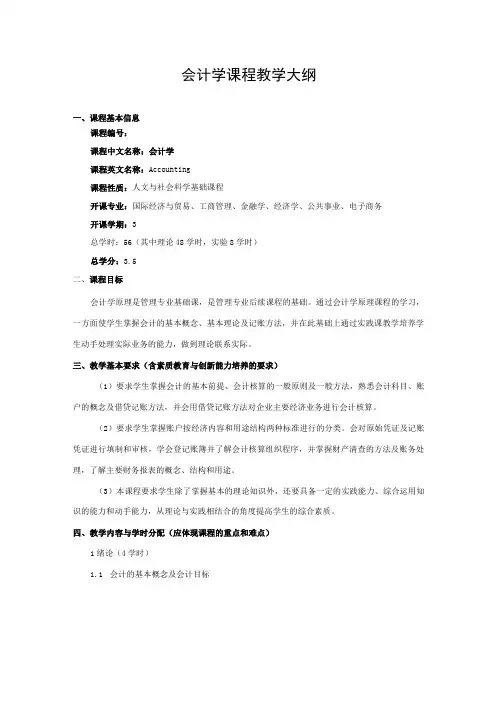
会计学课程教学大纲一、课程基本信息课程编号:课程中文名称:会计学课程英文名称:Accounting课程性质:人文与社会科学基础课程开课专业:国际经济与贸易、工商管理、金融学、经济学、公共事业、电子商务开课学期:3总学时:56(其中理论48学时,实验8学时)总学分:3.5二、课程目标会计学原理是管理专业基础课,是管理专业后续课程的基础。
通过会计学原理课程的学习,一方面使学生掌握会计的基本概念、基本理论及记账方法,并在此基础上通过实践课教学培养学生动手处理实际业务的能力,做到理论联系实际。
三、教学基本要求(含素质教育与创新能力培养的要求)(1)要求学生掌握会计的基本前提、会计核算的一般原则及一般方法,熟悉会计科目、账户的概念及借贷记账方法,并会用借贷记账方法对企业主要经济业务进行会计核算。
(2)要求学生掌握账户按经济内容和用途结构两种标准进行的分类。
会对原始凭证及记账凭证进行填制和审核,学会登记账簿并了解会计核算组织程序,并掌握财产清查的方法及账务处理,了解主要财务报表的概念、结构和用途。
(3)本课程要求学生除了掌握基本的理论知识外,还要具备一定的实践能力、综合运用知识的能力和动手能力,从理论与实践相结合的角度提高学生的综合素质。
四、教学内容与学时分配(应体现课程的重点和难点)1绪论(4学时)1.1会计的基本概念及会计目标1.2会计基本前提条件、会计信息基本要求1.1会计要素的含义、分类,2.2会计恒等式的经济含义及经济业务对会计恒等式的影响3.3会计科目的概念、设置原则及分类,账户及其一般结构重点为会计六大要素的含义,难点为会计恒等式的经济含义。
3复式记账(4学时)3.1复式记账原理,借贷记账方法及记账规则3.2会计分录4.3试算平衡重点和难点为借贷记账法。
4企业主要经济业务核算(24学时)4.1资金筹集业务账户设置及会计核算4.2供应过程业务账户设置及会计核算4.3生产过程业务账户设置及会计核算和产品生产成本的计算4.4销售过程业务账户设置及会计核算5.5财务成果业务账户设置及会计核算此章为重点章节,其中生产过程及销售过程的核算为本章的重点及难点。

会计学教学大纲
一、课程简介
1.1 课程名称:会计学
1.2 课程性质:必修课
1.3 课程学时:72学时
1.4 课程学分:4学分
二、课程目标
2.1 培养学生具有良好的会计学基础知识和基本技能
2.2 培养学生具备较强的会计实务操作能力和实际应用能力2.3 培养学生具备独立思考和解决问题的能力
2.4 培养学生具备团队协作和沟通能力
三、教学内容
3.1 会计学基本概念与会计职业道德
3.2 会计科目的分类与账户的基本操作
3.3 会计核算的基本原则与方法
3.4 会计报表的编制与分析
3.5 企业财务分析及管理决策
3.6 税收会计与审计
四、教学方法
4.1 理论教学结合案例分析,提高学生的实际应用能力
4.2 课堂讨论,培养学生的团队协作和沟通能力
4.3 作业辅导,巩固学生的会计核算操作技能
4.4 实践教学,让学生在实际工作场景中应用所学知识
五、考核方式
5.1 平时表现(包括课堂参与、作业完成情况等):20%
5.2 期中考试:30%
5.3 期末考试:50%
六、教材及参考书目
6.1 主教材:《会计学》
6.2 参考书目:《会计基础》、《财务报表分析》、《会计审计导论》
七、其他
7.1 学生必须按时上交作业,迟交者扣分处理
7.2 学生需认真听讲,积极参与课堂讨论
7.3 任何形式的作弊行为一经发现将取消考试资格
以上为会计学教学大纲内容,希望同学们能够认真学习,取得优异的成绩。
祝大家学习进步!。

《会计信息系统(双语)》教学大纲课程编号:041124B课程类型:□通识教育必修课□通识教育选修课□专业必修课 专业选修课□学科基础课总学时:64讲课学时:32实验(上机)学时:32学分:4适用对象:国际会计学(CGA)先修课程:包括会计学、财务管理学在内的专业基础课和专业课;管理信息系统;数据库及其应用。
一、教学目标(Course Objects)本课程重点学习会计信息系统的基本原理、会计信息系统的结构与功能,典型会计信息系统的使用与操作等,培养学生使用会计信息系统的实践能力,为将来同学从事会计实务打下扎实基础。
具体来讲,本课程教学目标包括:目标1:理解会计信息系统的原理、结构以及功能(To understand the basic principles, structures and functions of accounting information systems);目标2:理解销售收款循环、采购付款循环和生产成本循环的基本概念以及运行机制(To understand the basic concepts and operational mechanism of the revenue, expenditure and conversion cycles);目标3:理解财务报告系统和管理报告系统的原理(To understand theprinciples of financial reporting and management reporting systems);目标4:理解会计信息系统的内部控制(To understand the internal control of accounting information systems);目标5:理解如何管理系统开发生命周期(To understand how to manage the systems development life cycle);目标6:通过实验教学熟悉一个实际系统的结构与功能,学会使用该系统解决实际问题(To familiar with what is the structures and functions of a real AIS through experimental studies and know to apply the real AIS to solve the problems in practice)。
《国际会计》(双语)课程教学大纲课程编号:02133制定单位:会计学院制定人(执笔人):宋京津,王宏*******制定(或修订)时间:2011年8月26日江西财经大学教务处《国际会计》(双语)课程教学大纲一、课程总述本课程大纲是以2011年国际会计(双语)本科专业人才培养方案为依据编制的。
二、教学时数分配三、单元教学目的、教学重难点和内容设置Study guide for international accountingCHAPTER 1Introduction to international accountingLEARNING OBJECTIVES:1.To identify and understand the importance of the eight factors that has asignificant influence on accounting development.2.To understand the definition of IA of this textbook.3.To be familiar with the detailed contents of IACHAPTER OUTLINEDevelopment of IAEight factors▪Sources of Finance–In countries with strong equity markets, Disclosures are extensive to meet the requirements of widespread public ownership.–in credit-based systems where bans are the dominant source of finance, accounting focuses on creditor protection through conservative accounting measurements. Development of IA▪Legal System. The legal system determines how individuals and institutions interact.▪Taxation . tax legislation effectively determines accounting standards because companies must record revenues and expenses in their accounts to claim them for tax purposes.▪Political and Economic Ties. Accounting ideas and technologies are transferred through conquest, commerce, and similar forces.Development of IA▪Inflation. Inflation distorts historical cost accounting and affects the tendency of a country to incorporate price changes into the accounts.▪Level of Economic Development. This factor affects the types of business transactions conducted in an economy and determines which ones are most prevalent.Development of IA▪Education Level. Highly sophisticated accounting standards and practices are useless if they are misunderstood and misused.▪Culture. Cultural variables underlie nations’ institutional arrangements (such as legal systems)Definition of IAInternational accounting can be viewed in terms of the accounting issues uniquely confronted by companies involved in international business. It also can be viewed more broadly as the study of how accounting is practiced in each and every country around the world, learning about and comparing the differences in financial reporting and other accounting practices that exist across countries.Definition of IAThis book is designed to be used in a course that attempts to provide an overview of the broadly defined area of international accounting, and that focuses on the International Financial Reporting Standards (IFRSs) issued by International Accounting Standards Board (IASB) and some international hot topics.Detailed Contents on IA▪International accounting is a well-established specialty area within accounting and has two major dimensions:▪Comparative: Examining how and why accounting principles differ from country to country▪Pragmatic: accounting for the operational problems and issues encountered by individuals and firms in international business.Detailed Contents on IA▪L. Radebaugh and S. Gray (1993, p. 9) also write that the study of international accounting involves two major areas:▪descriptive/comparative accounting and the accounting dimensions of international transactions/multinational enterprises.▪principally covers the problems encountered by multinational corporations: Financial reporting problems, translation of foreign currency financial statements, information systems, budgets and performance evaluation, audits, and taxes.Objectives of Research on IA▪Global Harmonization. As business entities increasingly operate in multiple counties, they encounter the cost of dealing with diversity in financial reporting requirements.▪Financial Reporting in Emerging Economics. As ever increasing amounts of capital are invested in countries with emerging economics, the quality of financial reporting in these countries is coming under the microscope. Objectives of Research on IA▪Social and Environmental Reporting. One of the consequences of the globalization of business enterprises is that companies now have stakeholders not just in their home country but in all the countries where they operate.CHAPTER 2International accounting harmonizationLEARNING OBJECTIVES:1. Recognize the arguments for and against harmonization.2. Identify the pressures for and the obstacles to harmonization.3. Become familiar with the main organizations involved in harmonization. CHAPTER OUTLINEHistory and Recent Developments▪Prior to 1960, there was little effort devoted to the international harmonization of accounting standards. Efforts have been made by a number of organizations to reduce the differences between accounting systems since then.Main International Bodies InvolvedPrinciples-Based vs. Rules-Based Approaches▪Principles-based standards represent the best approach for guiding financial reporting and standard setting, of any given transaction.▪Rules-based standards provide companies the opportunity to structure transactions to meet the requirements for particular accounting treatments.Obstacles to Harmonization▪Differences in the regulatory framework .▪The "true and fair view" .▪The various interpretation of fundamental principle .▪ A binding tax accounting linkLikely future trends▪The convergence of IAS and national accounting standards is, and always has been one of the IASB's key objectives. Three basic future roles exist for the IASB:✓Producing standards for those countries that have no standards of their own✓Assisting in the reduction of diverse national practices✓Acting as an umbrella organizing for national standard settersImplication▪The demand of international capital markets helps to drive harmonization. IASB has become more cognizant of the need to work with national standard setters and bring them into membership of IASB, which may be possible to eliminate the differences between national and international standards. The current agreement could then be viewed as the first step in a much longer process.IASB ( International Accounting Standards Board)▪IASB's responsibilities:✓Develop and issue International Financial Reporting Standards and Exposure Drafts, and✓Approve Interpretations developed by the International Financial Reporting Interpretations Committee (IFRIC).CHAPTER 3ACCOUNTING FOR FOREIGN CURRENCYLEARNING OBJECTIVES:▪ 1. Provide an overview of foreign exchange markets and define related terminology.▪ 2. Describe the different types of foreign exchange exposure and exchange difference.▪ 3. Understand some of the more common foreign currency transactions. CHAPTER OUTLINEAccounting for Foreign Currency Transactions▪ a transaction that requires payment or receipt (settlement) in a foreign currency is called a foreign currency transaction.▪Exchange difference is the difference resulting from reporting the same number of units of a foreign currency in the reporting currency at different exchange rates. Accounting for Foreign Currency Transactions▪Importing or Exporting of Goods or Services✓At the date the transaction is first recognized.✓At each balance sheet date that occurs between the transaction date and the settlement date.✓At the settlement date.Accounting for Foreign Currency Transactions▪Recognition of Exchange Differences✓the single- transaction approach✓the two- transaction approachHedging Foreign Exchange Rate Risk▪A derivative instrument may be defined as a financial instrument that by its terms at inception or upon occurrence of a specified event, provides the holder (or writer) with the right (or obligation) to participate in some or all of the price changes of another underlying value of measure, but does not require the holder to own or deliver the underlying value of measure.Hedging Foreign Exchange Rate Risk▪two broad categories✓Forward-based derivatives, such as forwards, futures, and swaps, in which either party can potentially have a favorable or unfavorable outcome, but not both simultaneously (e.g., both will not simultaneously have favorable outcomes).✓Option-based derivatives, such as interest rate caps, option contracts, and interest rate floors, in which only one party can potentially have a favorable outcome and itagrees to a premium at inception for this potentiality; the other party is paid the premium, and can potentially have only an unfavorable outcome.Hedging Foreign Exchange Rate Risk▪Forward Exchange Contracts▪Options▪Fair Value Hedge – Using a Forward Contract▪Hedging an Identifiable Foreign Currency Commitment Using a Forward Contract (A Fair Value Hedge)▪Hedging a Forecasted Transaction Using an Option (Cash Flow Hedge) Translation Of Foreign Financial Statements▪Derivation of the Issue of Foreign Currency Translation✓Translation exposure, sometimes also called accounting exposure, refers to gains or losses caused by the translation of foreign currency assets and liabilities into the currency of the parent company for accounting purposes.✓The choice of any method for the translation of the financial statements of a foreign business operation involves two basic questions:(i) how shall foreign currency financial statements be translated——in particular what exchange rates are to be used for different assets/liabilities/equity accounts?(ii) how and when shall foreign exchange gains or losses be recognized?CHAPTER 4Business combinationsLEARNING OBJECTIVES:•(1)Understand the economic motivations underlying business combinations.•(2)Learn about the alternative forms of business combinations, from both the legal and accounting perspectives.•(3)Introduce concepts of accounting for business combinations;•(4)emphasizing the purchase method.•(5)See how firms make cost allocatCHAPTER OUTLINE➢ 4.1 The Accounting Concept of Business Combinations➢ 4.2 The Legal Form of Business Combinations➢ 4.3 Reasons for Business Combinations➢ 4.4 Accounting for Business Combinations Under the Purchase Method ➢ 4.5 The measurement of Goodwill and ControversyCHAPTER 5Consolidated financial statementsLEARNING OBJECTIVES:•(1)Recognize the benefits and limitations of consolidated financial statements.•(2)Understand the requirements for inclusion of a subsidiary in consolidated financial statements.•(3)Apply the consolidation concepts to parent company recording of the investment in a subsidiary at the date of acquisition.•(4)Allocate the excess of the fair value over the book value of the subsidiary at the date of acquisition.CHAPTER OUTLINE➢ 5.1 Demand from IAS 27➢ 5.2 The adjustment of Intercompany Transactions➢ 5.3 Parent Company Recording and Consolidated Statement of financial position at Acquisition Date➢ 5.4 Subsequent Statement of financial positionCHAPTER 6Accounting for changing priceLEARNING OBJECTIVES:▪ 1. Explain basic concepts relating to inflation accounting. Understand the distinction between changes in the general level of prices in an economy, which affect the purchasing power of the measuring unit, and changes in the prices of specific assets and liabilities, which affect balance sheet valuations and income measurement.▪ 2. Explain the underlying thoughts and methods of dealing with inflation.▪ 3. Restate conventional financial statements based on historical costs to a common measuring unit.CHAPTER OUTLINEDefects of historical cost accounting▪The results of comparison of performance and position statements over time will be unreliable, because amounts are not valued in terms of common units.▪Borrowings are shown in monetary terms, but in a time of rising prices a gain is actually made (or a loss in times of falling prices) at the expense of the lender as, in real terms, the value of the loan has decreased or increased.▪Conversely, gains arising from holding assets are not recognized.▪Depreciation writes off the historical cost over time, but, where asset values are low (because based on outdated historical costs), depreciation will becorrespondingly lower, so that a realistic charge for asset consumption is not matched against revenue in the performance statements.Overview of Accounting for changing prices▪Changing prices affect financial reports in two principal ways:✓Measuring unit problem✓Valuation problemAccounting Measurement Alternatives▪Acquisition Cost/Nominal Dollar Accounting▪Acquisition Cost/Constant Dollar Accounting▪Current Cost/Nominal Dollar Accounting▪Current Cost/Constant Dollar AccountingRestatement of Monetary and Non-monetary Items▪ A monetary item is a claim receivable or payment in a specified number of dollars, regardless of changes in the purchasing power of the dollar.▪ A non-monetary item is any asset, liability, or shareholders’ e quity account that has no claim to or for a specified number of dollars.Evaluation of Acquisition Cost/Constant Dollar Accounting▪When compared with current-cost accounting (discussed next), constant-dollar accounting carries a higher level of objectivity. Independent accountants can examine canceled checks, invoices, and other documents to verify acquisition-cost valuations and transaction dates. The restatements to constant dollars use general price indexes published by governmental bodies. Evaluation of Current Cost/Nominal Dollar Accounting▪Current-cost accounting measures performance and financial position in terms of the current market prices. Managers likely make decisions in terms of current costs, not out-of-date acquisition costs. Thus, for asses sing management’s actions, current-cost financial statements provide information on the same basis that management used to make decisions.▪Critics note two shortcomings of current cost/nominal dollar accounting:✓auditors cannot as easily verify current-replacement-cost valuations as they can acquisition-cost valuations.✓the use of nominal dollars means that the measuring unit underlying current-replacement-cost valuations varies across time.CHAPTER 7Accounting for financial instrumentLEARNING OBJECTIVES:1. Examine budgeting and performance evaluation issues for international firms.2. Discuss global risk management tools and strategies including multinational capitalbudgeting and foreign exchange risk management.3. Identify the main constituents of cross-border transfer pricing policies, define thetransfer pricing methods, and consider the issues in devising a transfer pricing strategy.4. Recognize the critical role of information technology systems in the effectiverecording, processing and dissemination of financial and managerial accounting information.CHAPTER OUTLINE1 Challenge for the accounting profession2 Accounting and Reporting for Financial Instruments: International Developments▪In the process of completing the most recent series of amendments, the IASB conducted an extensive due process, which began in 2001 and included the following:▪(1) Conducting numerous board deliberations prior to the June 2002 exposure drafts;2.1 Overview of IAS 32▪The following are the major U.S. standards that address financial instruments accounting and reporting:▪(1) SFAS 107, Disclosures About Fair Value of Financial Instruments.▪(2) SFAS 133, Accounting for Derivative Financial Instruments and Hedging Activities.▪(3) SFAS 140, Accounting for Transfers and Servicing of Financial Assets and Extinguishments of Liabilities.▪(4) SFAS 150, Accounting for Certain Financial Instruments with Characteristics of Both Debt and Equity.2.2 Overview of IAS 392.3 Recognition and Derecognition of Financial Assets and Liabilities2.4 Hedge Accounting Guidance2.5 Impairment of Financial Instruments2.6 Convergence with U.S. GAAP3 Financial instruments3.1 Illustration of Traditional Financial Instrument3.2 Illustration of Derivative Financial Instrument4 DERIV ATIVES USED FOR HEDGING▪SFAS No. 133 established accounting and reporting standards for derivative financial instruments used in hedging activities. Special accounting is allowed for two types of hedges—fair value and cash flow hedges.4.1 Fair Value Hedge4.2 Illustration of Interest Rate Swap4.3 Cash Flow Hedge5 OTHER REPORTING ISSUES▪Additional issues of importance are as follows:▪(1) The accounting for embedded derivatives.▪(2) Qualifying hedge criteria.▪(3) Disclosures about financial instruments and derivatives.Chapter 8 financial reporting in different countriesLearning objectives:•Identify the major policy-setting bodies and their role in the standard-setting process.•Appreciate US GAAP .•Understand convergence of US GAAP to IFRSs.Chapter outline:Parties Involved in Standard SettingSecurities and Exchange CommissionAmerican Institute of CPAsFinancial Accounting Standards BoardFinancial Accounting Standards BoardDue ProcessTypes of PronouncementsGovernmental Accounting Standards BoardGenerally Accepted Accounting PrinciplesIssues in Financial ReportingIssues in Financial ReportingConceptual FrameworkDevelopment of Conceptual FrameworkChapter 9 corporate governanceLearning objectives:1.describe the definition of corporate governance2.describe some corporate governance theory3.describe the principle of corporate governancechapter outline:2 What is corporate governance?3 Corporate governance theoryPrincipal-agent theoryClassical Stewardship Theory3.3 Modern Stewardship Theory3.4 Stakeholder TheoryPrinciples of corporate governanceCorporate governance modelsMechanisms and controls of corporate governance Features of poor corporate governance。
《会计英语》课程教学大纲课程编号:一、课程说明1. 课程代码2. 课程类别专业选修课3. 适应专业及课程性质财务管理专业专业选修本大纲适用于财务管理、会计学及相关专业。
《会计英语》是财务管理及相关专业的选修专长课之一,也是财务会计专业知识结构中的衍生部分。
《会计英语》是基于本土实际情况,并结合相应市场与企业需求开设一门面向国际化的实用性课程。
4. 课程目的(1)课程是在《中级财务会计》的基础上 , 以企业会计人员岗位能力为核心,对会计从业人员专业英语术语及会计循环处理能力的培养为主体。
为将来的实际工作奠定理论基础和一定的职业技能。
(2)通过该课程学习使学生能掌握常用会计英语表达的习惯并运用英语做出相应财务分析能力。
(3)培养学生运用互联网及阅读相关会计英语书籍能力,拓展会计知识,并具有并翻译相关英语文章能力。
(4)5. 学时与学分本课程课内学时为36学时,学分为2。
采用现代多媒体教学及专题讨论形式相结合,作业与相关实践不少4学时。
6. 建议先修课程本课程的先修基础课程为《大学英语》及专业相关课程《基础会计学》、《成本会计》、《管理会计》和《财务管理》。
二、课程教学基本内容及要求(1)会计概述 An overview of accounting计划学时:2 学时基本要求:(1)掌握会计定义与种类(2)掌握会计要素的确认和计量要求(3)掌握会计的基本前提假设(4)掌握会计信息质量教学重点及难点:(1)重点:会计要素的确认和计量;会计信息质量(2)难点:会计的基本前提假设基本内容:(1)会计与会计职业(2)会计假设(3)会计确认和计量(4)会计质量特征思考题:1.How does the job of a bookkeeper differ from that of an accountant?2.Why are ethics crucial in accounting?3.What is the basic requirement of accrual basis of accounting? What other accounting concepts or principles does this assumption interrelate?4.What does matching principle mean? Why is it important to income measurement?(2)会计循环 Accounting cycle计划学时:6 学时基本要求:(1)掌握恒等式与复式记账会计术语英语表达(2)掌握会计循环基本过程(3)掌握日记帐、总分类帐(4)掌握结账与试算平衡表编制教学重点及难点:(1)重点:会计循环基本过程;掌握日记帐、总分类帐(2)难点:结账与试算平衡表编制基本内容:(1)会计等式及复式记账法(2)会计循环概述(3)日记帐及总分类帐(4)调整分录与试算平衡思考题:1.What is the significance of introducing 'accounts' in accounting?2.Describe the difference between an unadjusted trial balance, an adjusted trial balance , and a post-closing trial balance.3.At what stage of accounting cycle are the journals used ?4.Discuss the significance of using subsidiary ledgers.5.Specify the types of adjustments that need to be made at the end of each accounting period.6.What are the major steps in preparing closing entries?7.Explain the uses of the trial balance.(3)财务报表 Financial statements计划学时:6 学时基本要求:(1)掌握资产负债表英语表达(2)掌握利润及现金流量表表达(3)掌握财务报表附注(4)运用财务指标进行财务状况分析教学重点及难点:(1)重点:会计报表(资产负债表,利润表,现金流量表)英语表达形式(2)难点:运用相关财务指标分析基本内容:(1)资产负债表(2)利润表(3)现金流量表(4)财务报表附注(5)财务报表分析思考题:1.Briefly describe the significance of financial statements.2.In what sense does the balance sheet be arranged?3.How can the items of an income statement be classified?4.What are the principal sources of debits and credits to Retained Earnings?5.Explain the difference between the direct and indirect methods of preparing cash flow statements .6.What are the widely used ratios? How to calculate them and what do they indicate or measure?课内实践活动计划学时:4 学时1.实践内容:阿兹利康公司财务报表分析/Financial statements analysis of AstraZeneca2.课内实践目的:通过课内实践学习学生应:1.理解相关外文年报资料2.掌握分析报告基本写作方法3.运用所学财务指标分析法对阿兹利康公司进行分析4.通过小组协作培养团队意识3.课内实践目的:(4)流动资产 Current Assets计划学时:4 学时基本要求:(1)掌握流动资产相关科目基本概念(2)理解现金管理与控制制度(Cash and Its control)应收帐款管理制度(Receivables Management)及存货管理制度(Inventory managements)(3)运用不同方法计算存货成本教学重点及难点:(1)重点:现金管理与控制制度应收帐款管理制度及存货管理制度(2)难点:存货成本计量基本内容:(1)现金及其控制(2)应收帐款(3)存货思考题:1.When do accounts receivables arise?2.Describe the procedures in which the requested balance of the allowance for doubtful accounts is determined by aging the accounts receivable.3.What is meant by cost flow assumption?(5)非流动资产与投资 Non-Current Assets and Investments计划学时:4 学时基本要求:(1)掌握非流动资产(Non-Current Assets)相关科目基本概念(2)掌握长期投资(Investments)相关科目基本概念(3)运用不同方法计算折旧教学重点及难点:(1)重点:非流动资产与长期投资相关科目英语表达(2)难点:折旧计算基本内容:(1)固定资产(2)固定资产折旧(3)无形资产思考题:1.How is the cost of plant and equipment determined?2.When are post-acquisition costs capitalized rather than expensed?3.What are the causes of depreciation?4.How should R&D costs be accounted for?(6)负债Liabilities计划学时:2 学时基本要求:(1)掌握流动负债(Current Liabilities)相关科目基本概念(2)掌握非流动负责(Non-current Liabilities)相关科目基本概念教学重点及难点:重点:流动负债相关科目英语表达非流动负责相关科目英语表达基本内容:(1)流动负债(2)非流动负责思考题:1.Define liability, current liability and non-current liability.2.What are bonds? Identify the types of bonds.(7)所有者权益 Owners’ Equity计划学时:2 学时基本要求:(1)掌握不同企业所有者权益核算(2)理解企业不同形式教学重点及难点:(1)重点:企业不同形式(2)难点:不同企业所有者权益核算基本内容:(1)企业组织形式(2)不同企业所有者权益核算思考题:1.Distinguish between par value and marked value.2.What is treasure stock. and why do companies acquire it ?(8)收入与费用 Revenues and expenses计划学时:2 学时基本要求:(1)掌握收入科目基本概念(2)掌握费用科目基本概念教学重点及难点:重点:收入科目英语表达费用科目英语表达基本内容:(1)收入(2)费用思考题:1. Clearly define expenses.2. What is the difference between direct expenses and indirect expenses?(9)其他相关会计 Other Accounting areas计划学时:1 学时基本要求:(1)掌握管理会计和成本会计基本概念(2)相关会计英语表达教学重点及难点:(1)管理会计和成本会计(2)相关会计职业及作用基本内容:(1)管理会计(2)成本会计(3)国际会计思考题:1.What is the purpose of cost accounting?2.Describe the role of management accounting in a business.(10)审计 Auditing计划学时:1 学时基本要求:(1)掌握审计流程(2)掌握内控制度教学重点及难点:(1)审计概念(2)审计流程(3)内部控制制度基本内容:(1)审计概论(2)审计流程(3)审计报告(4)内部控制思考题:1.Explain each type of audit procedures.三、课程学时分配本课程计划36学时,其中理论教学34学时,课内实践2学时。
会计学教学大纲一、引言会计学作为一门重要的管理学科,对于企业的经济运行具有重要的指导意义。
本教学大纲旨在全面掌握会计学基本理论与方法,培养学生的会计思维和实际操作能力。
通过系统的教学,帮助学生建立正确的财务分析与决策能力,为将来从事会计、金融等相关工作做好准备。
二、课程目标1.理解会计学的基本原理和方法,掌握财务报表的编制和分析。
2.培养学生的会计思维和问题解决能力,提高财务分析和决策的能力。
3.熟悉国内外会计准则和相关法律法规,遵守会计道德规范。
4.掌握实际操作技能,能够独立完成基本的财务会计工作。
5.培养良好的团队合作和沟通能力,培养创新精神。
三、课程内容1. 会计学基础知识•会计学的概念与发展•会计职业道德与会计准则•会计信息系统与内部控制•会计要素与会计等式•会计核算的基本步骤与方法2. 财务报表编制与分析•资产负债表的编制与分析•利润表的编制与分析•现金流量表的编制与分析•扩展财务报表分析方法3. 预算与管理会计•预算编制与控制•成本概念与分类•成本核算方法与成本控制•经营决策与管理会计4. 会计信息系统与财务管理•会计信息系统的设计与运行•财务分析与经营决策•资本预算与投资决策•企业财务风险管理四、教学方法1.授课与讨论相结合,注重理论与实践的结合。
2.实例分析,案例讨论。
3.班级小组讨论,培养团队合作和沟通能力。
4.桌面模拟实验,锻炼实际操作技能。
5.老师点评和学生互评,提高学生成绩。
五、评估方式1.平时表现(出勤、参与讨论)占总评成绩的20%。
2.课堂作业和小组报告占总评成绩的30%。
3.期中考试占总评成绩的20%。
4.期末考试占总评成绩的30%。
六、教材与参考书1.教材:•张无忌. 会计基础[M]. 清华大学出版社, 2020.•李四. 财务管理基础[M]. 高等教育出版社, 2019.2.参考书:•王五. 会计学[M]. 人民出版社, 2018. •赵六. 会计准则与国际会计[M]. 电子工业出版社, 2017.七、教学进度安排日期主题教学内容第1周会计学基础知识引言,会计学的概念与发展第2周会计学基础知识会计职业道德与会计准则第3周财务报表编制与分析资产负债表的编制与分析第4周财务报表编制与利润表的编制与分分析析第5周财务报表编制与分析现金流量表的编制与分析第6-7周预算与管理会计预算编制与控制第8-9周预算与管理会计成本概念与分类第10周预算与管理会计成本核算方法与成本控制第11-12周会计信息系统与财务管理会计信息系统的设计与运行第13周会计信息系统与财务管理财务分析与经营决策第14-15周会计信息系统与财务管理资本预算与投资决策八、教学辅助手段•多媒体教学设备•电子教学课件•实例分析和案例讨论•计算机会计软件的实践操作•考试试题和答案的提供以上即为《会计学教学大纲》的内容。
会计专业中英文双语融合教学法下的课程安排发表时间:2008-12-17T11:44:27.967Z 来源:《中小企业管理与科技》供稿作者:李彦东毛玉萍[导读] 摘要:中英文双语融合教学,客观上要求本着实事求是、一切从实际出发的态度,构建渐进的中英文双语融合教学目标体系,并在其基础上合理地进行课程设置。
只有课程设置合理了,才能激发学生的学习积极性,才能取得良好的中英文双语融合教学效果。
本文对《基础会计学》等课程应否进行中英文双语融合教学进行了详尽的阐述。
关键词:中英文双语融合教学基础会计学中级财务会计摘要:中英文双语融合教学,客观上要求本着实事求是、一切从实际出发的态度,构建渐进的中英文双语融合教学目标体系,并在其基础上合理地进行课程设置。
只有课程设置合理了,才能激发学生的学习积极性,才能取得良好的中英文双语融合教学效果。
本文对《基础会计学》等课程应否进行中英文双语融合教学进行了详尽的阐述。
关键词:中英文双语融合教学基础会计学中级财务会计0 引言为了顺利地开展中英文双语融合教学工作,必须要明确中英文双语融合教学目标、并结合学科特点科学地进行课程设置,这样才能取得较好的教学效果。
教学目标是教学体系建构的出发点,也是课程设置的依据和标准。
会计专业中英文双语融合教学目标的制定,应结合中英文双语融合教学的定义,反映经济全球化和教育国际化两个发展趋势,培养具有国际社会文化知识、懂外语、熟悉国际会计和商业惯例的高级会计管理人才。
通过中英文双语融合教学提高学生的外语水平,培养他们适应对外交流的能力,直接了解国外先进的会计理论和方法、掌握国际会计实务和惯例。
具体来讲,专业课中英文双语融合教学的目标应该是一个有差别的、层次分明的目标体系,在实践中要有一定的渐进性。
可以分为以下三个层次:第一层次,能大致听懂双语专业课程,能用常用英文词汇和句型进行简短的课堂发言,能借助字典看懂指定的专业英文教材,能正确使用英文完成作业;第二层次,能基本听懂专业双语课程,能用英文阐述自己的观点,能快速浏览教材并按要求查询重点,能用英语撰写简短专题文章;第三层次,能听懂双语课程,能用英文流利地表述观点、进行讨论,能熟练查阅国外专业期刊,能用英文撰写专题报告或论文。